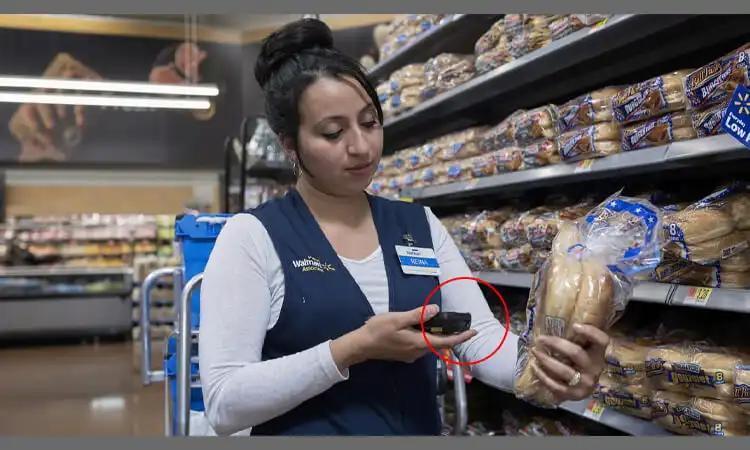Walmart’s partnership with RFID technology has been a game-changer in the retail industry. It has transformed how businesses manage inventory. This partnership has also enhanced the customer shopping experience. By digitizing inventory information and streamlining operations, Walmart has set the standard for RFID adoption in the industry. As RFID technology continues to evolve and become more accessible, it can potentially revolutionize the industry even further. In this blog, we will explore the evolution of Walmart RFID initiative and its impact on the retail industry.
Walmart RFID Technology: How It Improves Inventory Management
Walmart has recently announced a new mandate requiring all suppliers to apply RFID labels to all incoming products. This new RFID initiative will give the retail giant more control over its store inventory and ultimately provide a better customer experience.
RFID is not new technology for Walmart. Years ago, Walmart started piloting RFID to track pallet movement and improve warehouse operations. The new mandate builds on these efforts by requiring RFID tagging at the item level. This will allow Walmart to track the location and availability of products more accurately across its stores and distribution centers in real-time.
With RFID, Walmart can quickly find missing or misplaced products, reduce costly out-of-stock items, and optimize space through better space management. The increased visibility and control will also enhance product replenishment and forecasting accuracy.
The RFID mandate poses new challenges and costs for suppliers but maintains the promise of a better customer experience and a stronger partnership with Walmart. Walmart believes RFID will strengthen its competitive position and further its mission of helping people save money and live better lives.
Through RFID technology, Walmart aims to achieve one of the retail industry’s most advanced, dynamic inventory management systems. By leveraging data from billions of RFID tags, Walmart can transform how products move through its supply chain and evolve physical stores into smart shopping destinations. Overall, Walmart RFID mandate reinforces its leadership in innovation and signals a new chapter in retail powered by advanced technologies.
Walmart Plays a Pivotal Role in Bringing RFID to Prominence
Long before RFID became mainstream, Walmart helped raise awareness of the technology and its benefits. In 2003, Walmart announced that its top 100 suppliers would be required to attach RFID tags to all cases and pallets of incoming shipments. This move aimed to improve inventory management and enhance the customer experience.

Walmart’s RFID initiatives did not start with this announcement, however. The company had already launched an RFID-based inventory tracking pilot in seven stores in Texas in 2002, with eight product suppliers participating. Walmart also tagged high-value electronics like TVs, CDs, and stereos with RFID tags. The company aimed to gradually expand RFID to more stores, with a goal of company-wide implementation by the end of 2006.
Walmart’s leaders knew that inaccurate inventory counts were hurting sales and satisfaction. They believed RFID could provide greater supply chain visibility and more precise ordering, resolving key issues.
Walmart’s RFID mandate prompted other major retailers like Best Buy, Target, Home Depot, Tesco, and Metro Stores to experiment with and adopt the technology. With Walmart promoting RFID, the public became more aware of its potential benefits for retailers.
Overall, Walmart played a pivotal role in popularizing RFID and shaping its mainstream adoption. The company helped bring RFID to prominence through innovation, advocacy, and partnerships with suppliers and industry peers. Walmart’s efforts and influence helped pave the way for the widespread use of RFID technology that continues today.
By publicizing and implementing RFID at scale, Walmart established itself as an industry leader and shaped the future of retail with advanced technologies. The company’s role in promoting RFID has had a lasting and meaningful impact.
Related Articles:
- What is Passive RFID Tags and What is It Used for?
- What are Active RFID Tags and How Much does RFID System Cost?
- What are Semi Passive RFID Tags and What are Its Advantages?
Overcoming Challenges in Walmart’s Early RFID Initiative
When Walmart first introduced its RFID initiative, the technology was still in its infancy, and several challenges must be addressed. Some of the initial issues included:

- Who Would be Responsible for Purchasing RFID Tags?
Since both product suppliers and Walmart were new to the RFID system, it was unclear who was responsible for purchasing RFID tags, which was a significant obstacle.
Today, it is generally understood that the cost of RFID tags is included in the overall price of items purchased by the supplier or the retailer. This means that the tagging cost is factored into the product’s price and is ultimately passed on to the consumer.
Related Articles: 31 Top RFID Companies in World
- Achieving acceptable read rates at some locations.
with a significant portion of tags being unreadable due to interference from materials such as metals and liquids. Tag readability suffered, impacting inventory accuracy and management.
Today, specialized RFID tags and mitigation techniques effectively resolve read rate issues. Options include:
- Tags designed for water, metal, or other interfering materials. Waterproof, corrosion-resistant tags withstand environmental factors damaging early tags.
- RF-absorbing materials added to improve signal penetration. Materials absorb stray RF signals, reducing interference and improving read rates.
- Tuned tag antennas and chipsets. Enhanced tag components transmit more focused, powerful signals to improve readability.
Related Articles: Metal Tags, RFID Anti Metal Tags: What are They?
- Ineffective Adhesives
Early RFID tags sometimes used adhesives unable to withstand environmental factors, causing detachment from pallets or rendering tags unreadable. Tag adhesives were unreliable, jeopardizing tag adhesion and performance.
Today’s RFID tags feature robust adhesives that endure challenges like heat, cold, humidity, and physical stress during transit. Adhesives can also be customized for specific product or industry needs.
When Walmart first mandated RFID tagging, available tag options were more limited. Adhesive quality was an afterthought, as RFID was still emerging, and its potential was not fully realized. Weaker adhesives posed an obstacle, increasing costs from re-application or non-read tags.
Walmart helped drive progress by identifying adhesive issues, collaborating with suppliers on solutions, and gradually improving tag performance through testing. Though early weak adhesives prevented seamless RFID implementation, continued innovation has since resolved this challenge.
Stronger, more durable adhesives are now standard, bolstering RFID tag integrity, readability, and value. Like other hurdles, ineffective adhesives highlighted the need for enhanced technology and highlighted Walmart’s influence in shaping progress.
Through perseverance and partnerships, weak adhesives evolved into a non-issue, demonstrating how far RFID has come in the retail industry thanks to pioneering companies like Walmart. Overall, adhesive quality has little bearing on RFID adoption today, indicating the tremendous progress since Walmart’s mandate.
- Cost of RFID Tags
In the early 2000s, RFID tags were much more expensive, averaging around $0.50-0.75 per tag, compared to today’s average of $0.08-0.15 per tag.
However, Walmart’s initiative and subsequent adoption by other large retailers, such as Target and Tesco, helped to increase demand for RFID technology, leading to more efficient production processes and reduced costs. Furthermore, the development of better and smaller RFID tags also contributed to the decrease in cost over time.
Related Articles: The Most Comprehensive Cost of RFID System Analysis
The Success and Evolution of Walmart’s RFID Initiative
Walmart’s early adoption of RFID technology faced some initial challenges, but it has ultimately proven successful. According to a study by the University of Arkansas RFID Research Center, stores that incorporated RFID reduced out-of-stocks at the store level by 16% compared to non-RFID locations.

Despite some initial resistance from other retailers, Walmart’s use of RFID helped to raise public awareness of its potential benefits and drove the development of the technology. In addition to retail, RFID has succeeded in various industries, including timing races, tracking hospital equipment, and inventory control.
Over time, RFID technology has evolved and become more accessible. By 2010, Walmart could track shipments to stores and goods within stores using RFID technology company-wide. Walmart also began using RFID tags to track certain sales floor items like men’s jeans and underwear, which led to other major retailers like Bloomingdales and Macy’s adopting the technology to track clothing.
Today, all Walmart locations in the US use RFID to track incoming shipments and merchandise on the sales floor. RFID technology has proven to be a valuable tool for improving inventory accuracy and efficiency in retail and various other industries.
Related Articles:
The Future of RFID in Retail
With the shift towards e-commerce and the threat of the “retail apocalypse,” RFID technology has become an increasingly valuable tool for retailers. Here are some ways that RFID is already transforming operations for Walmart and other major retailers:
Walmart’s Use of RFID for Inventory Management and Customer Convenience
Walmart has been at the forefront of adopting RFID technology, leveraging it to manage inventory and improve the customer shopping experience. By using RFID to digitize inventory information, Walmart can provide accurate stock information online, enabling customers to easily see which items are in stock at each store and order out-of-stock items.
In addition to providing inventory visibility, Walmart has also introduced a convenient grocery pick-up system that allows customers to order goods online and retrieve them from the store when ready. Some Walmart locations also offer grocery delivery services. The use of RFID to track the quantity and location of in-store goods has made this system more efficient and cost-effective.
By using RFID technology, Walmart has been able to streamline its operations, reduce out-of-stock, and improve the shopping experience for customers. The success of Walmart’s RFID initiative has also helped to drive the development and adoption of RFID technology in various industries beyond retail.
Looking forward, the continued evolution of RFID technology promises to bring even more benefits to businesses and consumers alike. With its ability to improve inventory accuracy and efficiency, RFID has the potential to enhance the shopping experience and streamline operations across industries.
RFID Adoption by Other Retailers for Enhanced Shopping Experience
Retailers beyond Walmart are increasingly adopting RFID technology to enhance the shopping experience for customers in creative ways. For instance, luxury retailer Neiman Marcus has installed smart Memomi Memory Mirrors in dressing rooms that use RFID technology to detect the products a customer is wearing, displaying them as images on the mirror’s screen. The mirrors can also recommend similar products and accessories that customers can virtually try on, creating a personalized and efficient shopping experience.
Rebecca Minkoff, a luxury fashion retailer, has launched a new line of handbags with embedded RFID tags that allow owners access to special events, discounts, and private styling sessions. This innovative use of RFID technology enhances the customer experience and allows for more targeted marketing efforts.
These examples highlight the potential of RFID technology to revolutionize the retail industry by enabling retailers to personalize the shopping experience, improve inventory accuracy, and reduce costs. As RFID technology continues to evolve and become more accessible, more retailers are likely to adopt it to stay competitive and meet the evolving needs of their customers.
The Evolution of Walmart and RFID’s Partnership
The partnership between Walmart and RFID technology has been mutually beneficial, as both entities have evolved and grown together over time. Thanks to technological advancements and reduced costs, RFID tags have become more cost-effective and easier to use in large quantities to identify shipments and locate products on the sales floor.
The success of Walmart’s adoption of RFID technology is a valuable lesson for other retailers looking to stay relevant in the increasingly online world. By leveraging the benefits of RFID technology, retailers can improve inventory accuracy, enhance the shopping experience, and streamline operations.
As RFID technology continues to evolve and become more accessible, the potential applications in the retail industry are vast and constantly expanding. The possibilities for innovation are endless, from using RFID tags for improved supply chain management to shipping items to customers via drones.
Overall, Walmart’s partnership with RFID technology has been a success story of innovation and collaboration in the retail industry. As retailers seek new ways to engage with customers and stay ahead of the curve, RFID technology will likely play an increasingly important role.
General Q&A About Walmart RFID
-
Is Walmart still using RFID?
Yes, Walmart is still using RFID technology in its operations.
-
What RFID tags does Walmart use?
Walmart uses EPC Gen 2 RFID tags, designed to provide greater accuracy and reliability in tracking inventory levels.
-
What is RFID in Walmart?
RFID (Radio Frequency Identification) technology is a tool Walmart uses to track inventory levels, monitor stock movements, and improve supply chain management.
-
When did Walmart start using RFID tags?
Walmart began using RFID tags in its operations in 2004 as part of a pilot program to test the technology’s potential benefits.
-
What are the benefits of RFID for Walmart?
The benefits of RFID for Walmart include improved inventory accuracy, increased efficiency in supply chain management, reduced out-of-stocks, improved product tracking, and enhanced customer satisfaction. Additionally, RFID technology can help reduce labor costs and increase profitability by streamlining processes and reducing waste.








